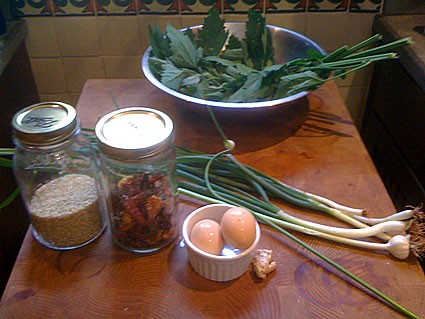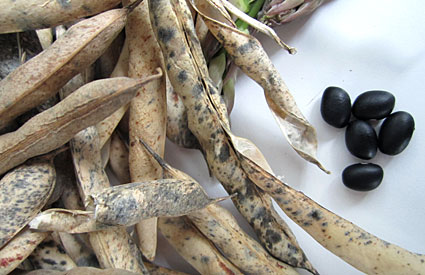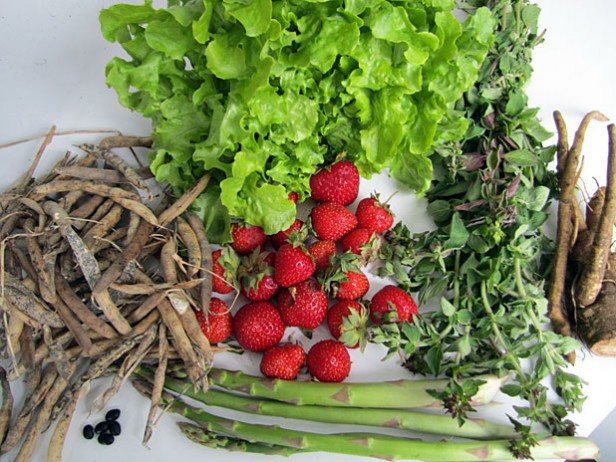 The rather mysterious contents of Box No. 2.(Jennnifer Prediger photos)
The rather mysterious contents of Box No. 2.(Jennnifer Prediger photos)
It’s week two of my journey as a CSA shareholder, which I’ll be chronicling in this Urbivore’s Dilemma series. (Read the first installment.) It’s been quite a learning curve so far. Not just from the vegetables and how to cook them, but also learning what to expect from a CSA.
The friend who encouraged me to join this CSA told me she and her husband split their share before with another couple. It was so much food, she said, they would have it over the course of two weeks. Expecting a bumper crop, I was surprised when my first half of the box seemed puny. I chalked it up to being the beginning of the season. The bounty would arrive in a matter of time.
That time is not yet here. This week, there were only eight stalks of asparagus, or two per person. That seemed a bit minuscule to my share-sharers. And last week there was only that one leek (that I loved!).
It made me wonder, is this the normal size of a CSA share? Is there such a thing as a “normal size”? Or maybe we’re sharing with too many people. There are four of us splitting the weekly supply of fruit and vegetables in typical 20-/30-something noncommittal, urban-dweller fashion. Perhaps it was an overshare — of the vegetable variety. Or maybe we had been afraid of biting off more than we could chew.
OK, I’ll admit it: I was afraid of that. I didn’t want to be held responsible for gorgeous food rotting in my refrigerator due to my lack of knowledge, skill, and/or time.
Given the supply and demand, our shareholders had a discussion about the split. One thought was to each get it every other week. I am gung-ho to see what’s growing each week, and I don’t want to miss anything. So that felt like a sad solution. We’re still trying to figure out the best approach. For the time, we’ve settled on giving all the leeks to one apartment so the other apartment can have a heartier number of asparagus.
So what should a person expect from their CSA share? At this point in the delicious journey, I have more questions than answers. Is my CSA share intended to be one night’s worth of food better than any other food I’ve tasted before? Should it stretch farther? Are CSAs for super-fresh groceries, or is it more of an uncooked supper-club kind of thing, like those people in Williamsburg, Brooklyn, who make fancy local meals?
Are CSAs fancy? Should I join multiple CSAs if I want to eat the CSA Way on more days? Is that too fancy?
Since part of the reason I joined this CSA was to get closer to my food source, I think I’ll go straight to the source — and ask the folks at Green Thumb Farm, where my veggies come from. I’ll let you know what they say next week.
But back to what it’s all about: the food.
The top picture above shows what I got this week: Strawberries, lettuce, oregano, asparagus, burdock root, and mystery leaves.
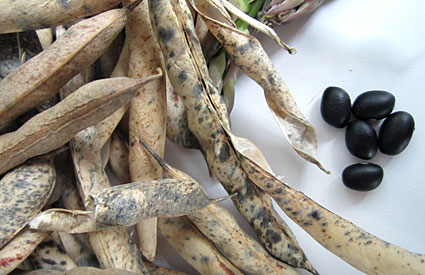 At my CSA, things are mysteriously unlabeled in an exciting way when you collect the food. You go around to a series of tables and take one of each item. A friend went with me this week. He picked up a brown paper bag full of what looked like sticks and leaves. Curious and disgusted, my pal asked if I was really sure I wanted to take that home. I insisted and in the tote bag it went.
At my CSA, things are mysteriously unlabeled in an exciting way when you collect the food. You go around to a series of tables and take one of each item. A friend went with me this week. He picked up a brown paper bag full of what looked like sticks and leaves. Curious and disgusted, my pal asked if I was really sure I wanted to take that home. I insisted and in the tote bag it went.
At home, the paper bag beckoned. I opened it and upon further inspection learned that these sticks were actually dried black-bean pods. A very exciting discovery! I’ve never made, or even had, a bean that fresh. I went away to Seattle for a work trip, so I didn’t have a chance to cook the beans yet. Thankfully, their shelf life seems long. My Mark Bittman How to Cook Everything Vegetarian cookbook has a lovely black-bean-and-oranges recipe I’d like to try, or maybe you have one you’ll share.
 What else didn’t I cook? The burdock root. It is waiting in the refrigerator for me to return home. Apparently the burdock root comes from the type of plant that has burrs that get into your clothes. Smart seed dispersal is just one of their fine traits.
What else didn’t I cook? The burdock root. It is waiting in the refrigerator for me to return home. Apparently the burdock root comes from the type of plant that has burrs that get into your clothes. Smart seed dispersal is just one of their fine traits.
My first inclination was to juice it — which I discovered after an Internet search is good for “blood purifying.” I could use a good blood-purifying juice. But there are so many other great things that can be done with burdock roots. They can be roasted and served with the finest of root vegetables. They sound like they’re delightful pickled, which how they are frequently served in sushi. And thank you to Joan Lambert Bailey, for your suggestion to use it in a rice dish. That sounds tasty and totally expanded my sense of what can be done with this funny brown thing.
So what did I actually cook? I went with simplicity. OK, I went with what I know. Pasta.
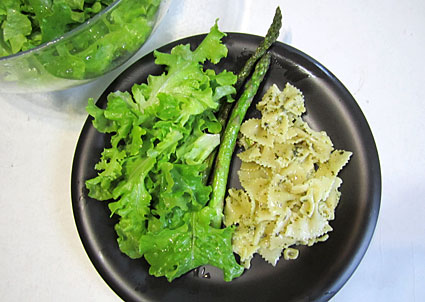 I cut up and used some of the purply, floral oregano with olive oil and garlic and basil. A tasty, tentative pesto, if you will. I cooked the four asparagus spears in my step-great-grandmother’s cast-iron frying pan with olive oil and sea salt, turning them over a few times over the course of about 10 minutes. Those were the tastiest two asparagus spears on record, I think. So fresh! And lightly frying them in the pan that way keeps them greeny-golden while staying crisp. The salt and oil seemed to caramelize the ends.
I cut up and used some of the purply, floral oregano with olive oil and garlic and basil. A tasty, tentative pesto, if you will. I cooked the four asparagus spears in my step-great-grandmother’s cast-iron frying pan with olive oil and sea salt, turning them over a few times over the course of about 10 minutes. Those were the tastiest two asparagus spears on record, I think. So fresh! And lightly frying them in the pan that way keeps them greeny-golden while staying crisp. The salt and oil seemed to caramelize the ends.
The lettuce was so brightly colored it was like an antidepressant. I dressed the leaves lightly with olive oil, apple cider vinegar, and salt. It was a simple and delicious meal. I didn’t really try out a new recipe, but with ingredients so fresh, they need such very little to make them sing. Maybe I’ll experiment with a more complex recipe this next week.
Because I want to progress! Have I progressed since last week? Well, if you consider buying a set of white restaurant plates at a charming used-things store in my neighborhood progress, then yes. At 75 cents each, they were a fine deal. What’s the saying? If you get the plates, the food will come …
In store for next week: Strawberries, mustard greens, lettuce, Swiss chard, lavender flowers, snow peas, or a choice of frisée or escarole. Goodness. Which should I choose?!
Readers, I yearn for your continued advice for how to combine ingredients in simple yet exciting dishes, and to hear what’s in your CSA boxes around the country each week as I share what I did with mine.
